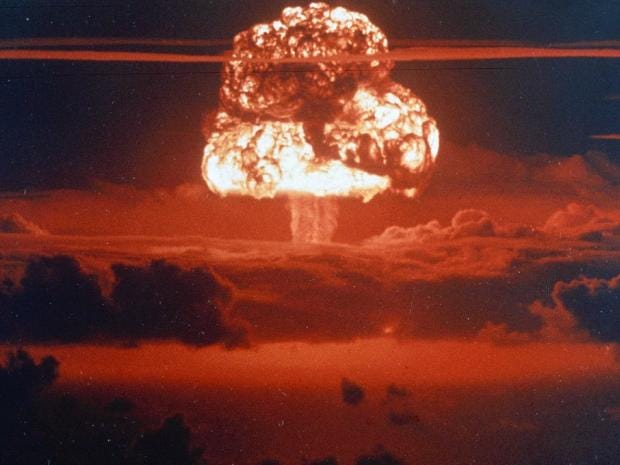
Donald Trump’s off-the-cuff comments about nuclear weapons have sparked fears of a new global arms race – but what would happen if an atomic bomb was dropped on your city?
Online tool Nukemap allows nervous civilians to position a hypothetical nuclear weapon above any building or major landmark in their town, to see how far the potential devastation could spread.
It uses details of historic and existing bombs to estimate the damage that would be wreaked at the centre of the blast and the surrounding area.
These include the 20 kiloton “Fat Man” warhead that decimated Nagasaki in 1945 and weapons currently held by nuclear powers, such as Russia’s 800 kiloton “Topol SS-25”.
Other bombs that can be ‘tested’ range from a 100 ton “crude nuclear terrorist weapon” to the 15 megaton hydrogen bomb “Castle Bravo”, the most powerful nuclear device ever detonated by the US.
Mr Trump raised the spectre of heightened nuclear tensions in coming years when he tweeted that the US “must greatly strengthen and expand its nuclear capability until such time as the world comes to its senses regarding nukes.”
“Let it be an arms race. We will outmatch them at every pass and outlast them all,” the President-elect later told MSNBC.
These comments have triggered fears Mr Trump will reverse decades of policy in which the US has, in tandem with Russia, sought to reduce its atomic arsenal.
The world’s largest nuclear device ever to be set off, the 50 megaton Soviet “Tsar Bomba” – detonated in a remote arctic test site in 1961, creating the most powerful man-made explosion in history – would kill an estimated 5.8 million people if it were dropped on London, according to Nukemap.
Thermal radiation causing third degree burns would spread as far as Reading, Southend and Haywards Heath.
Most residential buildings within the M25 would collapse and the majority of people in transport zone one of the capital would die from radiation exposure within a week.
Social media users reacting to Nukemap, created by American nuclear historian Alex Wellerstein, have expressed fear but also their relief at living far from the city centre.
“I selected the largest bomb possible on the list and detonated it over lower Manhattan and the line stopped 10 feet from my house. I'm good guys!” wrote one Reddit user.
Another said: “I feel like this game only exists to make people feel better about living in the suburbs”
Following the President-elect’s controversial post on Twitter, a Trump spokesperson attempted to explain the Republican’s remarks.
Trump secretary Sean Spicer said in several television interviews that there would not be an arms race because the President-elect would ensure that other countries trying to step up their nuclear capabilities, such as Russia and China, would decide not to participate.
“He’s going to ensure that other countries get the message that he’s not going to sit back and allow that,” Mr Spicer told NBC. “And what’s going to happen is they will come to their senses, and we will all be just fine.”
More than 2,000 nuclear tests were carried out across the world between 1945, when the US exploded its first atomic bomb, and the multilateral Comprehensive Nuclear Test Ban Treaty in 1996.
The Treaty bans all nuclear explosions, for both civilian and military purposes, and has been signed by 183 states at the UN headquarters.
However, it has not technically come into force as eight states – China, the US, Egypt, Iran, Israel, India, North Korea and Pakistan – have not ratified the treaty, even if they have signed it.
Soon after he was elected, Barack Obama spoke of "America's commitment to seek the peace and security of a world without nuclear weapons".
However, critics have said the President has put the US on course to spend $1 trillion on upgrading its nuclear arsenal, according to NPR.








